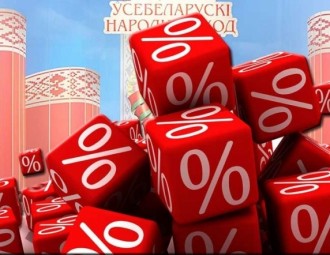Vadzim Iosub: None of the indicators of the current five-year plan has been fulfilled yet

Belarusan authorities are building plans for the forthcoming five years on the basis of the desirable prices on oil.
Belarusian authorities issued "Fundamentals of the program of the Belarus’ socio-economic development for 2016 - 2020 years” that are submitted for discussion on the 5th Belarusian People's Congress. Beautiful numbers in the document are pleasing to the eye: in 2020 GDP growth will amount to 12–15%; growth of real money incomes will reach 9.5-11.6%; lending rates will drop to 9-11%. Every Belarusian family will have the opportunity to build their own house or apartment, and life expectancy will grow up to 75.3 years. What is it if not a Belarusian economic miracle?
But is there real economic base under these beautiful numbers?
Vadzim Iosub, senior analyst of “Alpari”, answers the questions of the “EuroBelarus” Information Service.
- Prime Minister Andrei Kabiakou considers the overall result of the past five-year period as positive for Belarus, saying that the state fully met its social commitments to its people. Has the government really fulfilled its part of the social contract?
- The program of the current five-year plan includes a number of numerical parameters related to the economic growth, income growth, and the growth of exports and imports. As far as I remember, none of the indicators included in the program has been fulfilled.
We can manipulate the definitions; blame the global crisis and low oil prices. But the fact remains: the program indicators have not been met. It is necessary to have sufficient courage and imagination to state the different.
- But the authorities submitted a "Fundamentals of the program of the Belarus’ socio-economic development for 2016 - 2020 years” for discussion on the 5th Belarusian People's Congress, where, for example, the growth of real money incomes is forecasted at 9,5-11, 6%. Can we consider the declared goals realistic?
- I have an assumption that all the forecasts for the forthcoming five-year period are based on one single parameter – the world prices on oil. If, indeed, a consistent rise of oil prices will be observed for five years, then we can expect economic growth and growth in real incomes.
However, if oil scenario is not realized, with the existing economic system and the reluctance to radically change the structure of the economy there are no other sources of economic growth. Therefore, if no consistent increase of oil prices happens, we can predict in advance that within five years the government will fail to reach the planned parameters, blaming it on external factors, on the global crisis, and on low commodity prices.
- Given the fluctuations of oil prices, the calculations of the government can be called insane.
- Let's just say that no one dares to predict the oil prices for the next five years with a high degree of reliability for obvious reasons: high current volatility, big uncertainty with oil demand and supply (demand is highly dependent on the Chinese economy, which is slowing down), and other factors. Oil has risen up to $50 a barrel, which is a threshold followed by proposals from the US and Canada shale deposits. It's hard to count on a scenario that gives no guarantees. But in fact, Belarusian government is counting on that.
- The decrease in living standards of the population is obvious; the economic crisis is obvious to everyone. Only Lukashenka always insists on the "crisis of the minds." Why are the authorities so stubbornly unwilling to recognize the existing economic crisis?
- If they recognize the existing economic crisis, the next step has to be made, which is to name the reasons that led to the crisis. Endless references to external factors, and the global economic crisis, will no longer work; references to the decrease in oil prices also raise questions: why is our economy so dependent on a single parameter?
If we admit the crisis we will also admit that the so-called "unique economic model," the pride of the Belarusian authorities over the last 20 years, is, actually the cause of this crisis. And this model provides for the support of inefficient enterprises and lack of support for people who lost their jobs. On the one hand, we can no longer support inefficient enterprises; however, neither we can take drastic steps, as it would mean throwing people into the streets in situation where the unemployment benefit is about £10. This is the result of the unique Belarusian economic model.
- How can Belarusian economy develop in the near future?
- It’s impossible to predict the development of the economy, because there is no predetermined way. The trajectory completely depends on the unpredictable actions of the authorities.
-
03.01
-
07.10
-
22.09
-
17.08
-
12.08
-
30.09










































